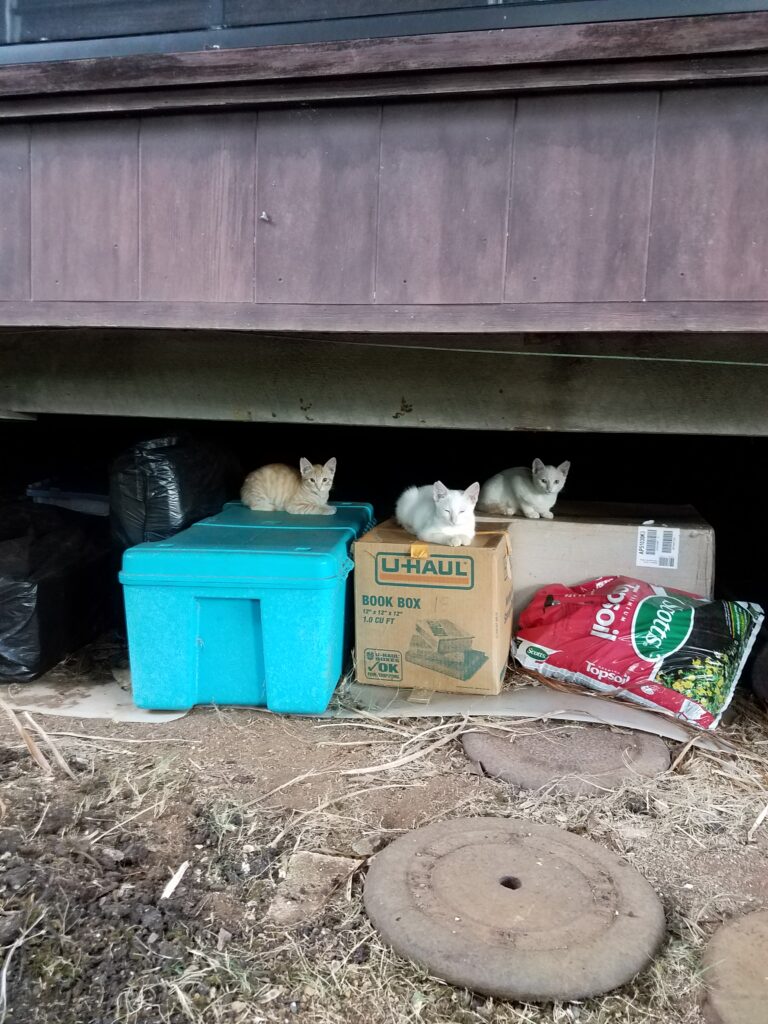A Free-Roaming Cat Family and Me (Part 1)

Part 1
In 2016, three emaciated cats that were barely bigger than kittens hunted geckos and rats under million dollar homes on this quiet mountain street. They optimistically raced up trees, trying to catch birds perched in shade trees in the overgrown backyard of the sixty year old house where my fiancé Barry and I had lived since 2013. Barry’s family had invited us to move in and help his brother Peter care for their ailing centenarian mother Lily.
Barry, a gifted chiropractor, loves helping people. He told me the reason people in our lives get sick is to teach us how to take care of them. To teach us how to give. Before Lily’s illness began, she and I had animated discussions about writing—she was a talented writer and an author like me. Lily and I were friends, and Barry’s words felt like wisdom, so I agreed to move in.
Barry and I settled into a routine of one of us always staying home so Lily was never alone. We watched that she didn’t fall or wander off, sat and talked with her so she didn’t feel lonely. I cooked her healthy food. After the cats showed up, I figured the same care-taking philosophy applied to homeless cats, who often died if no one cared enough to give them food and water.
My neighbor thought differently. “I chase feral cats away,” he said. “They poop in my yard, carry diseases, kill birds, keep me up all night yowling and fighting.”
“Yowling’s mating behavior,” I said. “I read that if you trap them and get them fixed, they quit fighting. The vet treats them for fleas and gives them distemper shots.”
“Me trap stray cats?” He looked at me like I was “touched” (crazy), as my grandmother used to say. “If I did, I’d drop them off at the Kahala parking lot. You heard about that one? Hundreds of ferals hang out there. People feed them…”
I figured dumping cats was better than taking them to the Humane Society to be killed, but it wasn’t fixing the problem. The neighborhood cats looked at me with nervous eyes hungry for help, appearing as thin as the two hands of a clock when it’s six o-clock on the dot. My gut cramped and I knew I could not let these helpless animals starve. I just couldn’t. One cat kept coming back; a diminutive beauty with white paws, green eyes, brown tortoise shell markings, and a sweet disposition unless I came too close. I left tasty scraps for her. She started sleeping on our boxes beneath the house.
Unknown to us, this kitty also hid behind Peter’s cobwebby, torn cardboard boxes that were occupying the left side of the covered patio beside Lily’s spare wheelchair. Barry’s and my plastic boxes with clip-on lids and a metal trunk stacked flush against the wall occupied the right side. Peters’ untidy boxes left cat-sized spaces between boxes and wall.
I never saw the petite beauty look even the least bit pregnant. Barely more than a kitten herself, this little Lolita kept her birthing and her babies hidden behind Peter’s boxes until the palm-sized babies were two weeks old. Then Mama Kitty could no longer contain their scrambling about, their falling off boxes, or stop them from peeking out from under Lily’s wheelchair.
Read More:
Part 1
Part 2
Part 3
Part 4
Part 5

Lizbeth Hartz is the author of the true crime, true love memoir Angel Hero, Murder in Hawaii, A True Story. Buy it on Amazon or sign up to read the 1st chapter free.